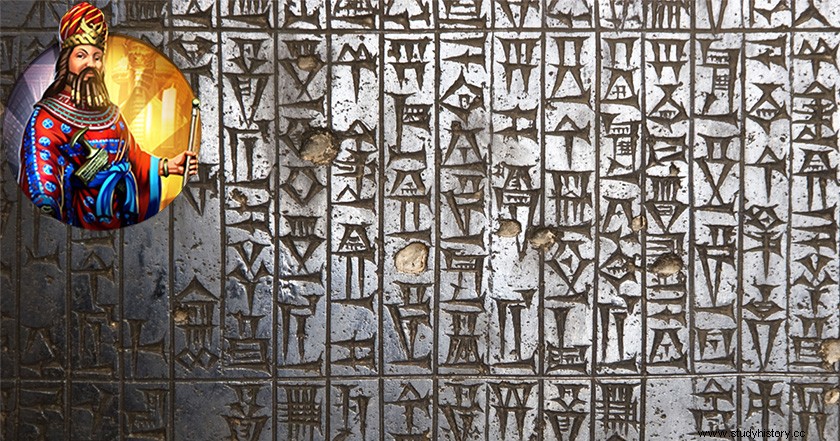
Hammurabi was the sixth king of the First Dynasty of Babylon, originally from the Amorite tribes settled around the fertile crescent between the III-II millennium BC. C. According to the so-called Median Chronology, he reigned in the city of Babylon between the years 1792-1750 a. C., placing this city in the context of Ancient History, thanks to his great gifts as a conquering king. With his conquests, the Babylonian territories expanded to Syria and southern Asia Minor, hence historiography has placed him as the founder of the Babylonian Empire.

The Babylonian Empire at the time of Hammurabi
But if this character stands out for any reason, it is because he is considered the first legislator in history . Obviously there must have been previous ones, and surely his laws were based on the compilation of the oldest, but the fact that he left them in writing is enough merit to grant him that title.
The trail known as the “Hammurabi Code ” was found out of context, hence we do not know the city where it was made, it is doubtful between the city of Sippar and Babylon itself, and we do not know the place where it was exposed. Note that it was found by a group of French archaeologists during work carried out on the Acropolis of Susa at the beginning of the 20th century. It is thought that it was transported there as spoils of war around 1200 BC. C.
When it was found it was broken into three large pieces, hence the loss of some parts of the writing, it also faced downwards. But its discoverers soon recognized that they were facing an exceptional piece. In less than three months it was in Paris, and after being reconditioned it was exhibited in 1902 at the Louvre in Paris, where by the way it continues to receive the millions of tourists and onlookers who pass through the museum's facilities.

The stele in the Louvre Museum
The Hammurabi Code it is written on a large slab of black basalt in the form of a stele, 2.25 m high. The inscription is made with cuneiform writing, in the Akkadian language. In the upper scene, the Babylonian king Hammurabi is observed receiving the laws of a seated God. The discussion revolves around whether this is Marduk , National God of Babylon, or Shamash , in this case the sun king protector of justice for some peoples settled around Babylon, most point to the second. Apart from the curious laws that we will describe later, on the stele there was a prologue and an epilogue, both of which serve to magnify the figure of the Babylonian king. Note, finally, that thanks to the numbering of cities that appear on this stela, its elaboration is attributed to the last years of Hammurabi's life, who we remember died around the year 1750 BC. C.
The laws of the Hammurabi Code.
Without further ado, let's get to know some of the curious laws that are a faithful portrait of ancient society. First of all, we have to point out that there are a total of 282 laws, although due to the breaking of the slab into three parts, those that go from 67 to 111 only some appear, others are broken, and finally some do not even appear. appear. They can be divided by theme, and although many of them are a perfect synthesis of the "Law of Talion", it is worth approaching them to get to know the society of the Old Regime better.
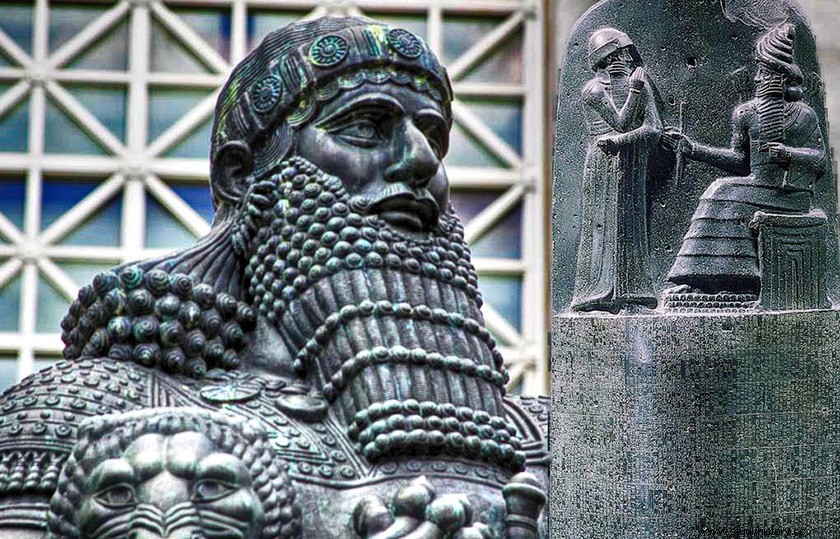
Hammurabi
From law 1 to 5, lies and false testimony were punishable.
Law number 2 is a prelude to the laws that will be imposed later in the Middle Ages, the trial of the Ordeal, that is, letting a superior being decide what should be done with the accused, he was present at Code Hammurabi.
2 “If anyone has cast a curse on a man without proof of guilt, the cursed person shall be thrown into the river. If you can't get out, your house goes to the one who cast the spell on you, but if the river 10 returns you innocent, safe and sound, your enemy is worthy of death, and the one who passed through the water test is the one who will take over the house. of the other”
From law 6 to 25, theft.
Theft was one of the great embarrassments for the Babylonian culture, and therefore strongly persecuted by the laws of Hammurabi. But it is evident that everything has a margin, it is not the same that a poor man steals than a rich man, equality was something that in the Babylonian culture did not seem to be "well seen".
8 “If anyone has stolen an ox, ram, pig, donkey, boat, from the temple or the palace, he will pay thirty times the value; if he is a nobleman, ten times the value, and if he has nothing to pay, he will be guilty of death.”
From Law 26 to 41, the protection of royal possessions.
Hammurabi protected his estate well from his subjects. Although we also find a curious law, by which we can deduce that at least the monarchy served to try to avoid corruption among the administrators of the kingdom. Let's not try to extrapolate this law to today, since we will have the risk of falling into a depression.
34 “If a governor or prefect seizes the property of an official, causes damage to him or exploits his services by renting them, he makes him appear by force in justice or seizes the salary that the king gives to the officials, that governor or prefect deserves death” .
From Law 42 to 66, agriculture and livestock.
The main occupation of the ancient world, that is agriculture and to a lesser extent livestock that have always gone hand in hand, should also be well protected by the laws of the Hammurabi Code. The law that I want to present to you is curious, in a world where by stealing a donkey you could end up in the grave. Farmers and ranchers were protected by law from potential abuse by lenders.
48 “If someone has a credit on the interest-bearing tenant, when the storm floods the field and destroys the harvest or the drought prevents the wheat from germinating, the tenant does not owe any amount of wheat that year to the creditor of the interest, he will wet his tablet and will not pay (in money) any interest that year.”
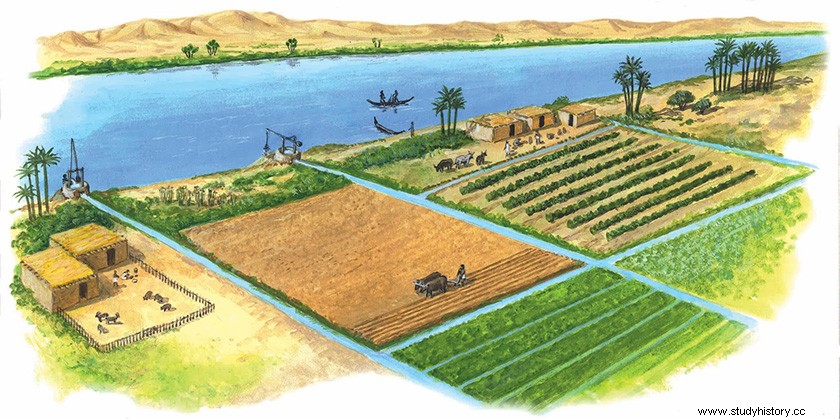
Idyllic image of agriculture in the Fertile Crescent
From law 67 to 111, the lost laws.
As has been reflected previously in this group of laws a large part of them have been lost, so the separation between two very different topics has not really been found. On the one hand, the laws relating to housing, and on the other those that regulated commerce, the latter, by the way, another of the important activities of the ancient world. Of all of them, one has caught my attention that regulated the bars of antiquity, which could already keep a good eye on their clientele, if they did not want to end badly.
109 “If rebels gather in the house of a wine vendor and are seized to lead them to the governor's palace, she deserves to be sentenced to death.”
From Law 112 to 126, bankers well controlled.
If anyone thinks that banks appeared in the Middle Ages, with the laws of Hammurabi some doubts may begin to arise, obviously their services are quite different, but not so far apart to those of the Middle Ages. Now, when reading the law that I am going to present to you, the first thing that comes to mind is that 4,000 years ago bankers were not trustworthy either.
122 “If someone wishes to deposit silver, gold or anything else, he must notify witnesses of the object of the deposit and set the obligations, and only then you can make the deposit.”
From law 127 to 194, personal relationships.
As we can deduce from their number, relationships between people occupy a large part of the Code of Hammurabi. After reading them we can draw several conclusions, one of them the complications that could arise in case of committing adultery.
129 “If a married woman has been caught sleeping with another, they shall be tied together and thrown into the water, unless the husband gives her quarter or the king to his servant.”
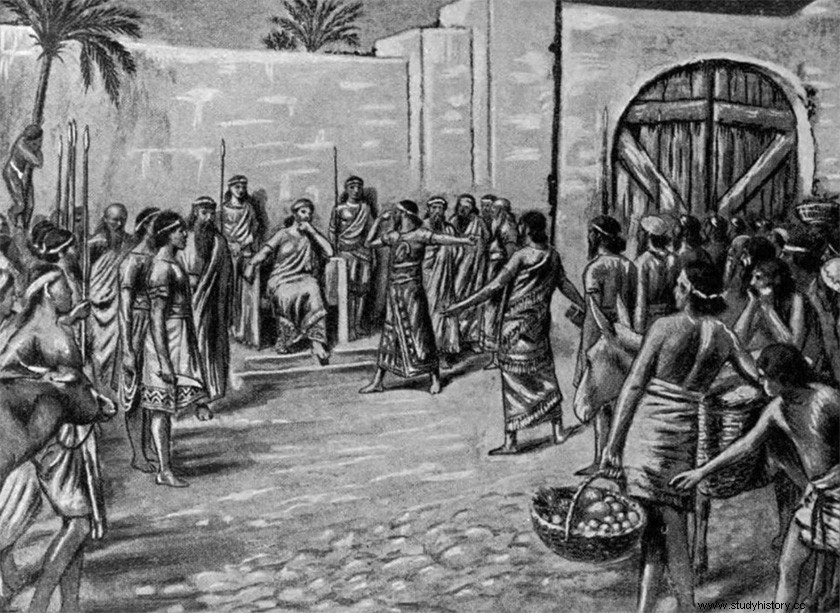
Recreation of a trial before Hammurabi
From Law 195 to 214, the law of talion at its best.
An eye for an eye, a tooth for a tooth or a member for a member, that is, the law of talion in its purest form. But yes, without forgetting the social condition of the individual, hence the slave society is completely outlined in the following two laws.
204 “If a nobleman hits a nobleman on the head, he will pay ten shekels of silver.”
205 “If a slave hits a free man on the head, he will cut off his ear.”
Doing the math, an ear was worth ten siscles of silver. In addition, the Hammurabi Code also had hidden protection laws for pregnant women, with somewhat ridiculous penalties. And counting on the application of the corresponding Talion law and of course without forgetting the class distinction.
209 “If anyone strikes a free woman and causes her to abort, she shall pay for her fruit 10 shekels of silver”.
210 “If this woman dies, she will kill the daughter (of the aggressor)”.
That is, if we go back to doing the calculations, a nobleman who slapped another nobleman had the same fine as an individual who caused a woman to miscarry with blows.
From law 215 to 277, the turn of the other professions.
If before we named agriculture and livestock with their particular laws, the rest of the professions of the Babylonian Empire were also governed by the Hammurabi Code. After reading them we can come to the conclusion that it was not easy to dedicate oneself to the liberal professions in Babylon. To show two examples; the first referring to doctors, and the second to architects.
219 “If a doctor treats the slave of a nobleman for a serious illness, with the bronze awl and kills him, he will return slave for slave.”
229 “If an architect has built a house for someone and has not made it solid, if the house collapses and kills the owner, this architect deserves death” .
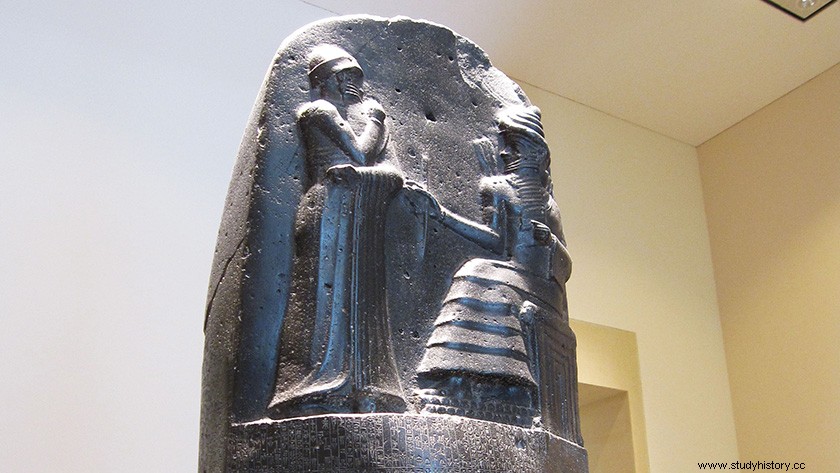
The delivery to Hammurabi of the laws of Mesopotamia
From Law 278 to 282.
Even for this, the slaves were last. A slave society like the Babylonian had to be reflected in the laws, seen what was seen and rereading the Hammurabi Code, the slaves in Babylon had a very complicated life.
Evidently it was different for the one I was buying, since even the slaves arrived with a guarantee certificate.
278 “If anyone has bought a slave, male or female, and if the latter is afflicted with an illness before the end of a month, the buyer shall return it to the seller and you will get back what you paid.”
So far this brief review of some of the 282 laws of the Hammurabi Code, undoubtedly one of the most reliable portraits of the societies of the ancient world. I invite you to get to know the rest at the following link:rcsdigital.homestead.com
More info:
A brief history of Babylon, Juan Luis Montero Fenollós, Ed. Nawtilus, 2012.
